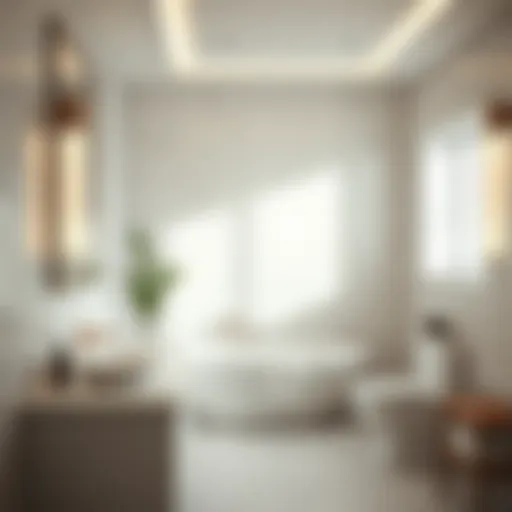The Subtle Elegance of a Light Grey Bedroom
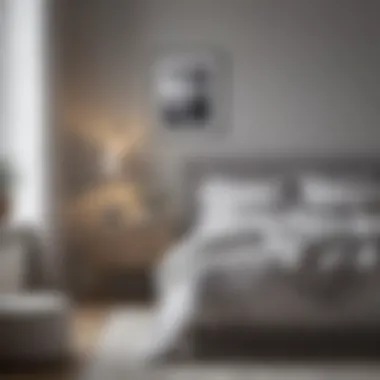

Intro
Light grey has emerged as a favored choice in bedroom design, not merely for its aesthetic appeal but also for its psychological benefits. The subtleties of this shade extend far beyond mere color; it influences mood, enhances spatial perception, and harmonizes with an array of decor styles. By diving into the nuances surrounding light grey, we can discover how it transforms a bedroom into a serene retreat.
Trending Styles
Modern Minimalism
In modern minimalism, light grey plays a vital role. This design ethos emphasizes simplicity and functionality, and light grey offers a clean canvas. The unadorned walls allow furniture and decor to stand out without clutter.
Key elements of modern minimalism include:
- Simple lines: Look for furniture with straight edges.
- Minimal accessories: Choose only essential decor items for a streamlined look.
- Natural light: Enable maximum daylight to complement the gentle hue.
Cozy Rustic
Contrastingly, light grey fits well in a cozy rustic setting. This style celebrates warmth through natural materials. Light grey can balance rustic tones of wood, stone, and textile. It adds a modern touch while still feeling warm and inviting.
Essential aspects to consider include:
- Textured fabrics: Incorporate cushions and throws made from wool or linen to enhance coziness.
- Wood accents: Use reclaimed wood pieces to maintain a connection with nature.
- Soft lighting: Consider warm bulbs for a welcoming glow.
Color Palettes
Calming Neutrals
Light grey harmonizes perfectly with other calming neutrals. Using tones like soft beige or pale taupe creates a cohesive and soothing environment. These combinations foster relaxation, promoting better sleep.
Some suitable pairings include:
- Light beige
- Soft white
- Dusty pastels
Bold Accents
For those seeking drama, adding bold accents can enhance the subtle elegance of light grey. Deep blues or emerald greens provide striking contrast while maintaining sophistication. This approach adds depth without overwhelming the senses.
Consider accents such as:
- Dark blue curtains
- Greenery or plants
- Vibrant artwork
Light grey creates a backdrop that complements both subtle and pronounced decor choices, leading to a versatile space that speaks to various design sensibilities.
Through thoughtful combinations and applications, light grey painted bedrooms can epitomize tranquility, ultimately enhancing well-being. Each layer of design from color selection to furniture style impacts how one experiences the space. Relating these elements can inspire homeowners to curate their own elegant sanctuaries.
Prelims to Color Psychology
Understanding color psychology is central to creating a harmonious and inviting space within your home. This article delves into how colors influence our emotions and thoughts in a bedroom setting. The choice of wall color, such as light grey, can profoundly affect one's mood and sense of well-being. By comprehending color theory, homeowners can make informed decisions that transform their bedrooms into serene retreats.
The Impact of Color on Mood
Colors act as emotional catalysts, impacting how we feel in a given space. Light grey, in particular, is known for its calming undertones. Research supports the idea that softer color tones promote relaxation, making them suitable for bedroom designs. This color encourages tranquility, reducing stress and anxiety, which can lead to better sleep quality.
"The color grey often reflects sophistication and timelessness, appealing to various design styles while maintaining a soothing ambiance."
Additionally, light grey can create an airy atmosphere in a room. It reflects light effectively, helping to brighten a space and enhancing the feeling of openness. Homeowners should consider these aspects when selecting colors, especially for environments meant for rest and rejuvenation.
Why Grey? Understanding Its Versatility
Grey holds an esteemed position in color psychology due to its versatility. It pairs well with a wide range of colors, enabling homeowners to customize their spaces without overwhelming them. Light grey serves as a neutral backdrop that allows brighter colors and textures to shine through without conflict.
This neutrality contributes to its elegance. It can camouflage imperfections on walls, making the room appear sharp and fresh. Moreover, light grey is easily paired with various decor styles, from modern and minimalist to more traditional schemes.
In practical terms, selecting light grey involves considering its undertones. For instance, some shades may have cool blue undertones, while others might lean warm with beige tints. Recognizing these subtleties helps homeowners curate a space that resonates with their personal taste and desired atmosphere.
The Aesthetic of Light Grey
The aesthetic of light grey in bedroom design is fundamental. It serves as a neutral base, allowing other design elements to shine. This color promotes a serene environment, which is essential for relaxation. Light grey conveys comfort while remaining sophisticated. The subtlety of this shade makes it a fitting choice for various styles, from minimalist to more eclectic designs.
A light grey wall can transform a room into a calming retreat. The hue reflects light in gentle ways, enhancing the overall brightness of the space. As a backdrop, light grey allows for vibrant colors in decor and furnishings to stand out. Additionally, it provides versatility in pairing with different materials and finishes.
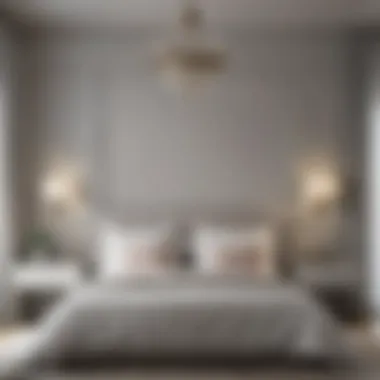

Light grey is suitable for both modern and traditional styles. It harmonizes well with warm and cool tones, thus expanding the design possibilities. Furthermore, it emphasizes simplicity and elegance, which makes it a valuable asset in any bedroom design.
Subtle Sophistication: The Appeal of Light Grey
Light grey offers subtle sophistication over more dominant colors. This hue possesses an understated elegance that feels contemporary yet timeless. It does not overwhelm the senses, making it an ideal choice for a space dedicated to rest. The neutrality of light grey encourages tranquility, aiding in relaxation which is crucial for a bedroom environment.
This color also communicates a certain level of refinement. It is chic without being pretentious. As a backdrop, it complements various styles of furniture and decor—allowing for personalization without excess. Homeowners can incorporate vibrant accents, including cushions, artwork, or textiles, to enhance the sophisticated feel of the space.
Creating Depth with Light Grey
Creating depth in a light grey bedroom enhances its visual interest. It ensures the space feels less flat and more dynamic. Two effective ways to achieve depth are through contrasting elements and layering textures.
Contrasting Elements
Contrasting elements play a crucial role in adding dimension to a light grey space. These can include darker tones or vibrant hues. The key characteristic of contrasting elements is their ability to highlight the light grey backdrop. For example, pairing dark wood furniture or bold blue accents can create a striking appearance. This approach is beneficial because it breaks the monotony while maintaining a cohesive look.
The unique feature of contrasting elements is that they draw the eye in specific directions. They encourage movement and exploration within the room. One disadvantage is that overdoing contrast can clash, undermining the calming atmosphere that light grey aims to provide.
Layering Textures
Layering textures is another strategy for creating depth. Using varied fabrics and materials enhances the tactile experience. Key characteristics of layering textures include richness and warmth. It can involve combining soft throws, heavier drapes, or decorative pillows in different textiles. This method is popular as it adds both comfort and sophistication to the space.
The unique feature of layering textures is that it invites touch and interaction with the space. Textured surfaces also interact with the light grey color, offering visual intrigue without overwhelming the senses. A potential drawback might be the necessity for careful selection to avoid clutter, which can detract from the serene feel that light grey promotes.
Choosing the Right Shade of Light Grey
Selecting the appropriate shade of light grey is crucial when designing a bedroom. The right shade can influence not only the aesthetic appeal but also the overall ambiance of the space. Light grey offers a neutral backdrop, making it easier to mix and match other colors and decor elements. Additionally, the subtlety of light grey can enhance the feeling of spaciousness, fostering a calm and serene environment. Understanding the different undertones and their effects can significantly inform your choice, leading to a space that feels cohesive and well-thought-out.
Undertones: Blue, Green, or Beige?
Each light grey paint comes with a distinct undertone that can change how the color is perceived in a room. For example, a light grey with a blue undertone can lend a cool, relaxing vibe, ideal for creating a tranquil retreat. This is particularly effective in bedrooms aimed at promoting restfulness.
Alternatively, grey shades infused with green undertones can evoke a sense of nature, resembling soft moss or sage. This type of grey is excellent for individuals looking to integrate natural elements into their design scheme.
On the other hand, light greys with beige undertones offer warmth. They create a cozy atmosphere, making spaces feel inviting without overwhelming the senses. This is often perfect for a bedroom, where comfort is of utmost importance.
Choosing the right undertone can make a substantial difference in how the space feels and functions. This decision may require testing multiple samples to find the perfect fit.
Testing Samples: The Importance of Lighting
When it comes to selecting paint, lighting plays a pivotal role in how the color is perceived. A soft grey may look different under natural daylight compared to incandescent or fluorescent light. Therefore, it is essential to test paint samples in different lighting conditions throughout the day.
Wall Painting Techniques
In the context of creating a light grey painted bedroom, wall painting techniques play a crucial role in achieving the desired aesthetic and emotional effects. How you paint the walls can determine the overall ambiance of the room. A precise application of techniques not only enhances the visual quality but also contributes to the longevity and durability of the paintwork. Mastering these skills ensures that the light grey color reflects tranquility and comfort, thereby fostering a serene atmosphere.
Preparation for a Perfect Finish
Preparation is essential for any painting project. Without proper preparation, even the highest quality paint may not adhere well or could lead to an uneven finish. Key steps include:
- Cleaning the Surface: Remove dust, dirt, and grease from the walls. This creates a clean canvas that allows paint to bond effectively.
- Repairing Imperfections: Fill holes, cracks, or dents with a suitable filler. For a smooth surface, sand these areas after they dry.
- Priming the Walls: Applying a good primer can enhance the richness of the light grey color and improve the paint's hold. Use a primer that matches the type of paint you choose.
Taking the time to prepare the walls leads to a better overall appearance, which can significantly enhance the elegance of the light grey hue.
Application Methods: Brushes, Rollers, or Sprayers?
Selecting the right application method is another critical aspect. Each technique offers its unique benefits:
- Brushes: Ideal for precision, brushes are great for corners and edges. They allow for detailed work, ensuring no area gets missed. A brush can also give a more textured look if desired.
- Rollers: These are effective for covering large areas quickly. Rollers help in applying an even coat, minimizing visible brush strokes. They also work well with thicker paint formulas, making them a preferred choice for walls.
- Sprayers: If speed is your priority and you want a flawless finish, paint sprayers may be your best bet. They cover large spaces in less time and can produce a very smooth coat. However, proper technique is necessary to avoid overspray and drips.
Choosing the right method often depends on the size of the room, the desired finish, and personal skill level.
Achieving an Even Coat
Getting an even coat of light grey paint is vital in ensuring the desired aesthetic. Here are some strategies to consider:
- Work in Sections: Divide the wall into manageable sections. This helps in applying a consistent coat and provides time to blend seamlessly.
- Use Uniform Pressure: Whether using a brush or roller, maintaining even pressure is key. Avoid pressing too hard to prevent drips and uneven texture.
- Apply Multiple Coats: It may be necessary to apply more than one coat for uniform coverage. Light grey can sometimes appear uneven, especially if the underlying wall color is darker.
By focusing on these aspects, you can ensure a professional-looking finish in your light grey bedroom, enhancing its subtle elegance and serene ambiance.
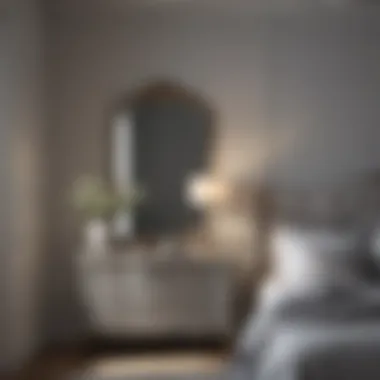

"A well-painted wall can transform any space into a true sanctuary."
For further guidance on painting techniques, consider reviewing resources like Wikipedia for color theory insights or Britannica for articles on home decor.
Complementary Decor Elements
In designing a light grey bedroom, selecting the right complementary decor elements is crucial to achieving a harmonious look. The choice of bedding, accessories, and art can either enhance or diminish the serenity that light grey offers. Focusing on cohesive design helps in creating a tranquil atmosphere essential for relaxation.
Bedding Choices for Light Grey Walls
Bedding plays a vital role in establishing a mood and comfort level in your bedroom. Choosing the appropriate bedding can improve the aesthetic of light grey walls significantly.
Fabric Options
Fabric choice is fundamental when considering bedding for a light grey bedroom. Options like cotton, linen, and silk can bring a different feel to the space. Cotton is widely favored due to its breathability and softness, making it a practical choice for various climates. Linen, with its relaxed texture, adds an element of casual elegance. Silk, although luxurious, may not be as practical for everyday use.
Each fabric has its unique benefits:
- Cotton: easy to wash, durable, and hypoallergenic
- Linen: naturally breathable, becomes softer with each wash
- Silk: feels luxurious, has a subtle sheen
The choice of fabric impacts both comfort and the room’s overall appearance. Some fabrics also interact interestingly with light, enhancing the gentle tones of a light grey wall.
Color Pairing Techniques
Choosing colors that pair well with light grey is essential for creating a cohesive look. Different techniques can be used, such as monochromatic, analogous, and complementary color schemes. Monochromatic schemes, which rely on different shades of grey, offer a sophisticated look that is understated.
For example, pairing light grey with deeper greys can create dimension without being overwhelming. Analogous schemes, which incorporate colors next to grey on the color wheel, often include soft blues or greens. These combinations can create a soothing yet visually appealing palette. Complementary color techniques can be utilized as well, where a splash of color such as a pastel yellow or blush pink can enliven the soft grey without overpowering it.
The advantage of these pairing methods is that they can guide you toward maintaining a tranquil yet visually stimulating environment within the bedroom. Additionally, they help ensure that the light grey painted walls remain the focus while complementary colors enhance the overall design.
Accessorizing with Art and Wall Decor
Art and wall decor are instrumental in adding personality to a light grey bedroom. The choice of artwork should resonate with the calming qualities of grey. Large, abstract pieces in muted colors can offer visual interest without being jarring. Alternatively, a collection of framed prints can create a gallery wall, adding character without overwhelming the space.
Wall decor may also include mirrors or shelves that can reflect light and create an illusion of space. Practical decor, such as floating shelves or functional art pieces, merges aesthetics with utility, enhancing the overall space without compromising style.
Incorporating art and decor should always drive toward achieving a balanced atmosphere, showcasing personal style without disrupting the calming influence of the light grey.
In summary, when designing a light grey painted bedroom, complementary decor elements should be chosen carefully to enhance the desired ambiance. The bedding, art, and additional decor must work together to create a unified space that promotes relaxation and sophistication.
Lighting Considerations
Lighting plays a crucial role in defining the overall ambiance and aesthetic of a light grey painted bedroom. Whether through natural light or artificial sources, the lighting you choose can significantly enhance or diminish the effects of this versatile hue. The interplay between light and the shade of grey present in your bedroom can either create a soothing environment or impart a cold feeling, depending on how it is utilized.
By carefully considering lighting options, homeowners can ensure that the elegance of light grey is both highlighted and complemented. This section will explore the specific elements and benefits of lighting choices when designing a grey-themed bedroom.
Natural Light: The Grey Effect
Natural light is pivotal when it comes to showcasing the subtle tones of light grey. During daytime, sunlight interacts with grey walls, bringing out different undertones and making the space feel alive and inviting. Sunlight can shift in intensity and color throughout the day, resulting in a dynamic environment that enhances relaxation and comfort.
Key points to consider with natural light:
- Direction: Determine the direction your bedroom windows face. South-facing windows provide warm, abundant light, while north-facing windows can produce a cooler, softer glow.
- Windows: Use sheer curtains to diffuse sunlight while maintaining privacy. This allows light to bathe the room in a soft glow, flattering the elegant tones of light grey.
- Shadows: Be mindful of how shadows play across your light grey walls. Depending on the time of day, the light source can create engaging contrasts that add depth and interest to the space.
"A bedroom filled with natural light creates a calming environment that promotes well-being and relaxation."
Artificial Lighting: Choosing Fixtures that Complement
Artificial lighting is essential for times when natural light is insufficient. The right fixtures can enhance the overall aesthetics of your light grey bedroom while providing functionality. When selecting lighting, it is important to focus on the style and tone of the fixtures in relation to your grey walls.
Consider the following aspects:
- Layered Lighting: Combine ambient, task, and accent lighting to achieve a balanced atmosphere. Ambient lighting provides overall illumination, task lighting is used for specific areas like reading nooks, and accent lighting draws attention to certain decor elements.
- Color Temperature: Opt for warm white bulbs to create a soft, inviting feel. Cooler tones can clash with the warmth of light grey and create a stark environment.
- Fixture Style: Choose fixtures that resonate with the theme of your bedroom. Modern, minimalist designs can enhance a contemporary room, while vintage or rustic fixtures can offer a charming contrast.
The Role of Nature in Bedroom Design
Incorporating nature into bedroom design is not just a trend but a necessity for creating a harmonious living space. The essence of nature can profoundly affect our mood and overall well-being. In the context of a light grey painted bedroom, natural elements play an essential role in softening the space and promoting tranquility.
Bringing elements of nature indoors helps establish a connection with the environment, which can be very calming. Plants and natural materials enhance the aesthetic appeal of light grey, providing texture and depth. They are more than just decorative items; they filter air and can even reduce stress levels. Thus, integrating nature into bedroom design is beneficial both for visual appeal and psychological comfort.
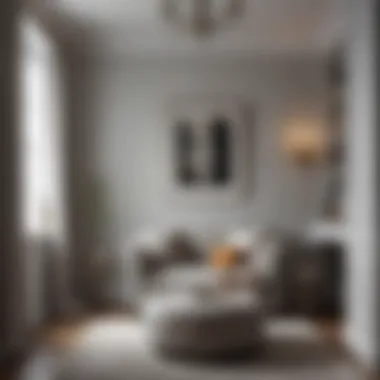

A well-balanced bedroom environment that incorporates nature creates a retreat where one can relax and rejuvenate. It’s about creating a space that nurtures the mind and body, perfectly complementing the soothing qualities of light grey.
Incorporating Plants for a Fresh Look
Plants are an incredibly effective way to introduce life and freshness to a light grey painted bedroom. They not only add color but also improve air quality. For instance, peace lilies and snake plants can thrive in low light, making them ideal for many bedroom settings.
Using a variety of plants can keep the room visually interesting. Here are some points to consider when choosing plants:
- Size and Scale: Select plants that fit well in the space, considering height and breadth. A tall potted plant can make a striking statement, while smaller succulents can complement bedside tables.
- Maintenance: Choose plants based on your ability to care for them. Some plants require more sunlight and frequent watering than others.
- Placement: Consider areas where natural light is limited. Hanging plants or wall-mounted pots can be decorative and useful.
Incorporating plants not only improves aesthetics but fosters a healthier indoor environment. The lush greenery against light grey walls creates a refreshing contrast that is both pleasing and calming.
Natural Materials: Wood, Stone, and Fabric
The choice of materials is crucial in bedroom design. Natural materials such as wood, stone, and fabric infuse warmth and character into a light grey painted bedroom. Each of these materials has unique benefits that enhance the overall feel of the space.
- Wood: Wooden furniture, such as beds or dressers, adds a touch of organic beauty. The grain and color variations can introduce warmth, contrasting gently with light grey.
- Stone: Incorporating stone elements, whether through a feature wall or accessories, evokes a sense of permanence and stability. Smooth stones can be used in decor, while slate or granite can be considered for surfaces.
- Fabric: Textiles such as linen or cotton can enhance coziness. Choosing neutral or muted tones, such as beige or light taupe, ensures that the environment maintains a serene atmosphere without overwhelming the senses.
Incorporating these natural materials will provide tactile experiences, making the bedroom not just a place to sleep but a sanctuary to enjoy during all hours of the day.
"Integrating nature into your bedroom design isn’t just about aesthetics; it is integral to fostering well-being and comfort."
By carefully selecting plants and natural materials, homeowners can craft a light grey painted bedroom that resonates with elegance and peace.
Case Studies in Light Grey Bedroom Design
Case studies in light grey bedroom design serve as invaluable resources for homeowners and decorators. They illustrate practical applications of this versatile color, showcasing how different styles can be harmoniously achieved. By examining real-life examples, readers can better understand the benefits of using light grey, such as its calming effects and ability to create a sophisticated aesthetic. Observing these case studies allows individuals to draw inspiration for their own spaces while considering important aspects like layout, lighting, and complementary decor.
Minimalist Approaches
Minimalism in design emphasizes simplicity and functionality. When using light grey, a minimalist bedroom can create an atmosphere of calm and clarity. The bedroom may feature clean lines, fewer furniture pieces, and a limited color palette, which includes soft whites or muted pastels to pair with the light grey.
In a minimalist light grey room, furniture should focus on practicality. A simple bed frame with minimal detailing enhances the overall elegance without overpowering the space. Incorporating space-saving solutions, such as built-in storage, not only maximizes space but also maintains a tidy appearance.
Proponents of minimalism often choose light grey for its neutrality. This allows for the seamless integration of personal touches, such as artwork or decorative objects. The tranquility of light grey can transform a simple bedroom into a soothing retreat.
Eclectic Combinations
The eclectic style celebrates diversity and variety in designs. Light grey, as a base color, allows for a dynamic mix of textures, patterns, and styles. An eclectic grey bedroom might combine vintage furniture with contemporary decor, providing both visual interest and a sense of comfort.
To achieve an eclectic design, start with light grey walls which can serve as a canvas for bold accents. Layering textures is essential. Consider plush bedding, wooden accents, or metal elements. Each piece should reflect personal taste.
One might incorporate vibrant colors in pillows or a statement piece of artwork. This can create contrast and warmth against the soft grey backdrop. Balancing different styles while keeping the light grey foundation ensures that the room does not become overwhelming.
Using light grey in eclectic designs allows homeowners to express their individuality while maintaining a cohesive look. It enhances creativity, making the bedroom not just a place to sleep, but a personal sanctuary.
Final Thoughts on Light Grey Bedrooms
The discussion surrounding light grey as a primary color in bedroom design culminates in understanding its profound impact on creating a soothing yet sophisticated environment. This segment emphasizes the many benefits of integrating light grey into a bedroom's palette. The elegant simplicity of light grey not only promotes relaxation but also serves as a flexible backdrop for various styles and decorative elements.
When homeowners consider light grey, they often appreciate its timeless appeal and versatility. It complements both modern and traditional decor, making it a strategic choice for anyone looking to refresh their space without committing to overly bold colors. The understated elegance of light grey allows for easy integration with a variety of other hues, offering endless possibilities for bedding, accessories, and accent walls.
"Color has a power of persuasion that can influence our emotions and perceptions of space."
Moreover, light grey functions exceptionally well in different lighting contexts. Its reflective properties enhance natural light in a room, creating a brighter atmosphere. This quality enables the colors and textures of other design elements to shine, while also maintaining a tranquil ambiance. It is particularly beneficial for smaller bedrooms, where light grey can contribute to an airy and spacious feel.
The Lasting Appeal of Light Grey
The enduring quality of light grey in bedroom designs lies in its ability to seamlessly evolve with changing trends. It presents a canvas that adapts to the whims of personal style while remaining sophisticated and serene. Homeowners can effortlessly switch themes by altering bed linens, artwork, or accent pieces, all without needing to repaint the walls.
Here are some key reasons behind the sustained popularity of light grey in bedroom designs:
- Timelessness: Unlike trendy colors, light grey does not quickly become outdated.
- Compatibility: It matches a wide array of colors, making it easy to accessorize with bright or dark tones.
- Psychological Benefits: Grey promotes calmness, which is essential for a restful sleep environment.
Overall, the lasting appeal of light grey reflects its status as a staple in interior decor. It exemplifies a simple yet impactful choice that aligns with contemporary aesthetics.
Creating Your Personal Sanctuary
Designing a personal sanctuary involves careful consideration of elements that promote comfort and well-being. A light grey painted bedroom serves as an excellent foundation for crafting such a retreat. Here are several approaches to transform a light grey space into a personal haven:
- Thoughtful Decor Choices: Choose bedding and accessories that evoke a sense of comfort. Soft fabrics like cotton or linen in complementary colors can create a welcoming atmosphere.
- Layered Lighting: Implement various lighting sources that allow for flexibility. Soft, warm lighting options can enhance the soothing effect of the grey walls and encourage relaxation.
- Personal Touches: Display personal items that bring joy or sentimentality, whether through photographs or meaningful artwork.
By integrating these elements, homeowners can refine their light grey bedroom into a sanctuary that embodies relaxation and self-expression. The calming palette and purposeful accessories will invite tranquility, making it a space conducive to rest and rejuvenation.
Ultimately, light grey stands out as a color that not only decorates a bedroom but also deeply influences the atmosphere and psychology of the space.





